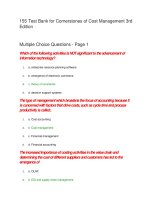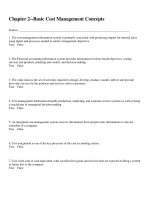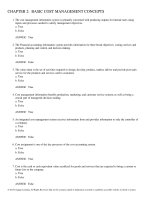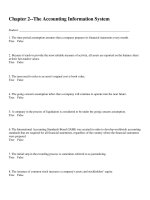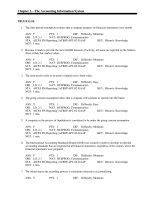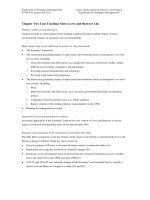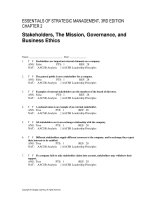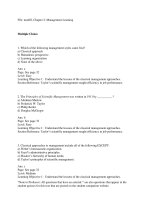Cornerstones of cost management 3rd edition hansen test bank
Bạn đang xem bản rút gọn của tài liệu. Xem và tải ngay bản đầy đủ của tài liệu tại đây (757.66 KB, 57 trang )
CHAPTER 2: BASIC COST MANAGEMENT CONCEPTS
1. The cost management information system is primarily concerned with producing outputs for internal users using
inputs and processes needed to satisfy management objectives.
a. True
b. False
ANSWER: True
2. The Financial accounting information system provides information for three broad objectives: costing services and
products, planning and control, and decision making.
a. True
b. False
ANSWER: False
3. The value chain is the set of activities required to design, develop, produce, market, deliver and provide post-sales
service for the products and services sold to customers.
a. True
b. False
ANSWER: True
4. Cost management information benefits production, marketing, and customer service systems as well as being a
crucial part of managerial decision making.
a. True
b. False
ANSWER: True
5. An integrated cost management system receives information from and provides information to only the controller of
a company.
a. True
b. False
ANSWER: False
6. Cost assignment is one of the key processes of the cost accounting system.
a. True
b. False
ANSWER: True
7. Cost is the cash or cash equivalent value sacrificed for goods and services that are expected to bring a current or
future loss to the company.
a. True
b. False
ANSWER: False
© 2015 Cengage Learning. All Rights Reserved. May not be scanned, copied or duplicated, or posted to a publicly accessible website, in whole or in part.
Chapter 2: Basic Cost Management Concepts
8. The three methods of cost assignment are direct tracing, driver tracing, and allocation.
a. True
b. False
ANSWER: True
9. Assigning costs accurately to cost objects is of low priority. Accuracy is not evaluated based on knowledge of
some underlying “true cost”.
a. True
b. False
ANSWER: False
10. The most precise of the three methods of cost assignment is direct tracing since it relies on observable causal
relationships.
a. True
b. False
ANSWER: True
11. Services differ from tangible products on three dimension: intangibility, perishability, and inseparability.
a. True
b. False
ANSWER: True
12. Intangible products are goods produced by converting raw material into finished products through the use of labor
and capital inputs.
a. True
b. False
ANSWER: False
13. Production costs are costs associated with manufacturing goods or providing services and are classified as direct
materials, direct labor, and overhead.
a. True
b. False
ANSWER: True
14. Conversion cost is the sum of direct materials and direct labor cost and prime cost is the sum of direct labor and
overhead cost.
a. True
b. False
ANSWER: False
© 2015 Cengage Learning. All Rights Reserved. May not be scanned, copied or duplicated, or posted to a publicly accessible website, in whole or in part.
Chapter 2: Basic Cost Management Concepts
15. Product costs include production, marketing, and customer service, and are used for strategic design decisions and
tactical profitability analysis.
a. True
b. False
ANSWER: True
16. The income statement prepared for external parties is frequently referred to as absorption-costing income, or full
costing income.
a. True
b. False
ANSWER: True
17. The cost of goods sold is the cost of direct materials, direct labor and overhead attached to the units sold.
a. True
b. False
ANSWER: True
18. The cost of goods manufactured represents the total manufacturing cost of goods completed during the current
period.
a. True
b. False
ANSWER: True
19. Work in process consists of all partially completed units found in production at a given point in time.
a. True
b. False
ANSWER: True
20. Gross margin, also called gross profit, is the difference between sales and costs of goods sold.
a. True
b. False
ANSWER: True
21. Cost management systems can be broadly classified as traditional or activity based.
a. True
b. False
ANSWER: True
© 2015 Cengage Learning. All Rights Reserved. May not be scanned, copied or duplicated, or posted to a publicly accessible website, in whole or in part.
Chapter 2: Basic Cost Management Concepts
22. A traditional cost accounting system assumes that all costs can be classified as fixed with respect to changes in the
units or volume produced.
a. True
b. False
ANSWER: False
23. The overall objective of an activity-based cost management system is to manage activities to reduce costs and
improve customer value.
a. True
b. False
ANSWER: True
24. The cost accounting system that emphasizes tracing over allocation is called an activity-based accounting system.
a. True
b. False
ANSWER: True
25. Error costs are costs associated with measurements required by the cost management system and measurement
costs are the costs associated with making poor decisions.
a. True
b. False
ANSWER: False
26. A subsystem of the accounting information system designed to satisfy costing, controlling and decision making
objectives is called the
system.
ANSWER: cost management
27. The cost management subsystem designed to provide accurate and timely feedback concerning the performance of
managers relative to their control of activities is the
information system.
ANSWER: operational control
28. The overall objective of accounting information is to provide information to
.
ANSWER: users
29. The resources given up that are expected to bring a current or future benefit to the organization are called
__________ .
ANSWER: costs
© 2015 Cengage Learning. All Rights Reserved. May not be scanned, copied or duplicated, or posted to a publicly accessible website, in whole or in part.
Chapter 2: Basic Cost Management Concepts
30. Expired costs used up in the generation of revenues are called
.
ANSWER: expenses
31. The least accurate but easiest to apply method of cost assignment is the
method.
ANSWER: allocation
32.
means the consumer cannot see, hear, feel, or taste a service before it is bought.
ANSWER: Intangibility
33.
are generally materials necessary for production that do not become part of the finished product or
are not used to provide a service.
ANSWER: Supplies
34. Costs necessary to market and distribute a product or service are often referred to as
order- __________ and order- __________ costs.
ANSWER: getting; filling
35. In preparing an income statement,
and
costs are separated.
ANSWER: production; nonproduction
36. Gross margin is the difference between
and the cost of goods or services sold.
ANSWER: sales revenues
37.
income is the difference between gross margin and selling and administrative expenses.
ANSWER: Operating
38. Cost management systems are made up of two subsystems: the
control system.
accounting system and the
ANSWER: cost; operational
39. Generally, more managerial objectives can be met with an activity-based system than with a
system.
ANSWER: traditional
40. In deciding whether to implement a(n)
cost management system, managers must evaluate the tradeoff between costs of measurement and cost of errors.
ANSWER: activity-based
© 2015 Cengage Learning. All Rights Reserved. May not be scanned, copied or duplicated, or posted to a publicly accessible website, in whole or in part.
Chapter 2: Basic Cost Management Concepts
41. The set of interrelated parts that performs one or more processes to accomplish specific objectives is called a(n):
a. cost objective
b. system
c. activity
d. cost driver
ANSWER: b
42. The overall objective of accounting information systems is to
a. provide information to users.
b. manage the organization.
c. prepare financial reports.
d. report to the government.
ANSWER: a
43. In an accounting information system, which of the following is NOT a transformation process?
a. collecting data
b. performance reports
c. analyzing data
d. summarizing data
ANSWER: b
44. Which of the following is a cost management subsystem designed to assign costs to individual products and services
and other objects, as specified by management?
a. financial accounting information system
b. operational control information system
c. cost accounting information system
d. all of the above
ANSWER: c
45. In a company that supplies muffins to bakeries, which of the following would be considered an input?
a. delivered muffins
b. flour
c. baking
d. none of these
ANSWER: b
© 2015 Cengage Learning. All Rights Reserved. May not be scanned, copied or duplicated, or posted to a publicly accessible website, in whole or in part.
Chapter 2: Basic Cost Management Concepts
46. In a company that supplies muffins to bakeries, which of the following would NOT be considered an input?
a. delivered muffins
b. flour
c. egg
d. oil
ANSWER: a
47. In a company that supplies muffins to bakeries, which of the following would NOT be considered a transforming
process?
a. delivered muffins
b. baking
c. packaging
d. mixing
ANSWER: a
48. In a company that supplies muffins to bakeries, which of the following would be considered a transforming
process?
a. delivered muffins
b. baking
c. egg
d. oil
ANSWER: b
49. In a company that supplies muffins to bakeries, delivered muffins to bakeries would be a(n)
a. interrelated part.
b. input.
c. output.
d. process.
ANSWER: c
50. In an accounting information system, the inputs are usually
a. financial statements.
b. analyzing data.
c. economic events.
d. performance reports.
ANSWER: c
© 2015 Cengage Learning. All Rights Reserved. May not be scanned, copied or duplicated, or posted to a publicly accessible website, in whole or in part.
Chapter 2: Basic Cost Management Concepts
51. Which of the following is a cost management subsystem designed to provide accurate and timely feedback
concerning the performance of managers and others relative to their planning and control of activities?
a. financial accounting information system
b. operational control information system
c. cost accounting information system
d. all of the above
ANSWER: b
52. The accounting information subsystem that is primarily concerned with producing outputs for external users is
called:
a. cost management information system
b. computer system
c. internal accounting system
d. financial accounting information system
ANSWER: d
53. High quality cost management systems should have an organization-wide perspective. Which of the following would
NOT be a benefit of a cost management system?
a. increases speed by ignoring non-financial information
b. reduces duplicate data storage and use of data
c. improves timeliness of reports
d. increases the efficiency of generating reliable and accurate information
ANSWER: a
54. Which of the following is a major subsystem of the cost accounting information system?
a. ERP
b. Operational control information system
c. OLAP
d. EDI
ANSWER: b
55. A computerized information system that strives to input data once and to make it available to people across the
company for different purposes is called a:
a. cost management information system
b. enterprise resource planning system
c. internal accounting system
d. financial accounting information system
ANSWER: b
© 2015 Cengage Learning. All Rights Reserved. May not be scanned, copied or duplicated, or posted to a publicly accessible website, in whole or in part.
Chapter 2: Basic Cost Management Concepts
56. A cost management subsystem designed to provide accurate and timely feedback concerning the performance of
managers and others relative to their planning and control activities is called the:
a. cost accounting information system
b. financial accounting system
c. operational control information system
d. tax reporting system
ANSWER: c
57. Which of the following is NOT one of the features of an operational control information system?
a. to assist in continuous improvement of all aspects of the business
b. to improve the value received by customers
c. to provide product cost information needed by management
d. to improve profits by improving value
ANSWER: c
58. Which of the following is NOT an objective of the operational control system?
a. increasing value to customers
b. increasing profit by providing value
c. Increasing post purchase costs
d. all of the above
ANSWER: c
59. The resources given up that are expected to bring a current or future benefit to the organization are represented by:
a. Costs
b. Expired costs
c. Expenses
d. Losses
ANSWER: a
60. The cash or cash equivalent value sacrificed for goods and services that are expected to bring a current or future
benefit to the organization is/are called:
a. Expenses
b. Cost
c. An activity
d. A loss
ANSWER: b
© 2015 Cengage Learning. All Rights Reserved. May not be scanned, copied or duplicated, or posted to a publicly accessible website, in whole or in part.
Chapter 2: Basic Cost Management Concepts
61. A cost used up in the production of revenues is a(n)
a. unexpired cost.
b. loss.
c. expense.
d. asset.
ANSWER: c
62. Which of the following is an example of a loss?
a. the cost of a product delivered to a customer
b. the cost of a delivered advertising campaign
c. the cost of the purchase of equipment
d. the write-off of an obsolete product
ANSWER: d
63. Which of the following is an example of an expense?
a. the cost of a proposed advertising campaign
b. the cost of a product delivered to a customer
c. the cost of the purchase of equipment
d. the write-off of an obsolete product
ANSWER: b
64. Which of the following is an example of a possible cost object?
a. a product
b. a customer
c. a department
d. all of the above
ANSWER: d
65. Traceability is a function of
a. an indirect relationship to the cost object.
b. distortion.
c. a causal relationship.
d. none of these.
ANSWER: c
© 2015 Cengage Learning. All Rights Reserved. May not be scanned, copied or duplicated, or posted to a publicly accessible website, in whole
or in part.
Chapter 2: Basic Cost Management Concepts
66. Factors that cause changes in resource usage, activity usage, costs and revenues are called
a. indirect costs.
b. drivers.
c. assignments.
d. cost objects.
ANSWER: b
67. The most likely method to assign the cost of an assembly-line supervisor when the assembly line is the
cost object is the:
a. driver tracing method
b. arbitration method
c. allocation method
d. direct tracing method
ANSWER: d
68. Which cost assignment method would likely assign the cost of heating in a plant that makes beds and
dressers when the bed product line is the cost object?
a. driver tracing
b. direct tracing
c. allocation
d. arbitration
ANSWER: c
69. Which cost assignment method would likely assign the cost of maintenance for machines in a
department that does cutting when the cutting activity is the cost object?
a. driver tracing
b. direct tracing
c. allocation
d. arbitration
ANSWER: a
70. Which of the following expenses incurred by a department store is a direct cost for the women's shoe
department?
a. the salespersons' commissions in the women's shoe department
b. the salaries for individuals working in the accounting department
c. the advertising expense for the service department
d. the allocated rent expense for the clothing department
ANSWER: a
© 2015 Cengage Learning. All Rights Reserved. May not be scanned, copied or duplicated, or posted to a publicly accessible website, in whole
or in part.
Chapter 2: Basic Cost Management Concepts
71. Which of the following costs incurred by a chair manufacturer would be traced to the product cost
through direct tracing?
a. the depreciation on factory equipment
b. the supervisor's salary
c. the insurance on the factory building
d. the woodworker's salary
ANSWER: d
72. Direct costs
a. are incurred for the benefit of the business as a whole.
b. would continue even if a particular product were discontinued.
c. are those costs that can be easily and accurately traced to a cost object.
d. can be assigned to products only by a process of allocation.
ANSWER: c
73. The direct costs of operating a college computer center would NOT include
a. rent paid for computers.
b. a fair share of college utilities.
c. paper used by the center.
d. computer consultants' salaries.
ANSWER: b
74. Which of the following methods of assigning costs is based on convenience or some assumed linkage,
and reduces the overall accuracy of the cost assignments?
a. direct tracing
b. driver tracing
c. allocation
d. all of the above
ANSWER: c
75. Which of the following costs incurred by a bus manufacturer would NOT be directly attributable to
the finished product?
a. the wages paid to assembly-line production workers
b. the tires for buses
c. the windshields for buses
d. the depreciation on factory building
ANSWER: d
© 2015 Cengage Learning. All Rights Reserved. May not be scanned, copied or duplicated, or posted to a publicly accessible website, in whole
or in part.
Chapter 2: Basic Cost Management Concepts
76. The assignment of indirect costs to cost objects is referred to as:
a. Allocation
b. Direct tracing
c. Physical observation
d. Cost management
ANSWER: a
77. What is a disadvantage of assigning costs evenly over all cost objects?
a. not all costs will be assigned
b. total costs will be distorted
c. costs may be distorted by consumption patterns of other cost objects
d. none of these
ANSWER: c
78. The insurance paid on the factory is
a. a direct cost if the cost object is the factory.
b. an indirect cost if the cost object is the product produced.
c. could be either a direct cost or an indirect cost, depending on the cost object.
d. all of the above.
ANSWER: d
79. Which of the following would NOT be a cost that could be directly traced to a custom piece of
furniture based upon physical observation?
a. the wood and upholstery materials that are in the final piece
b. the depreciation paid on factory equipment t
c. he labor of the worker assembling the piece of furniture
d. the labor of the woodworker who finishes the wood of the piece
ANSWER: b
80. The precision of driver tracing depends upon
a. physically observable relationships.
b. the strength of causal relationships described by the driver.
c. allocation estimations.
d. both b and c.
ANSWER: b
© 2015 Cengage Learning. All Rights Reserved. May not be scanned, copied or duplicated, or posted to a publicly accessible website, in whole
or in part.
Chapter 2: Basic Cost Management Concepts
81. If physical observation can NOT be used to identify the exact amount of resources consumed by a cost
object, the next best approach is
a. driver tracing.
b. allocation.
c. estimation.
d. none of these.
ANSWER: a
82. Services differ from tangible products in which of the following dimensions?
a. intangibility
b. inseparability
c. perishability
d. all of the above
ANSWER: d
83. With regards to products, perishability can be defined as
a. buyers of products who cannot see, feel, hear or taste the product before it is bought.
b. services that cannot be stored.
c. buyers and sellers who must be in direct contact for the sale to take place.
d. buyers of the product who do not need direct contact with the manufacturer of the product.
ANSWER: b
84. Intangibility of services means that
a. products cannot be seen, tasted, heard or felt before the purchase.
b. products cannot be stored.
c. exchange takes place in direct contact.
d. both a and c.
ANSWER: a
85. An example of a tangible product, rather than a service, would be
a. housekeeping.
b. insurance coverage.
c. paper.
d. medical exam.
ANSWER: c
© 2015 Cengage Learning. All Rights Reserved. May not be scanned, copied or duplicated, or posted to a publicly accessible website, in whole
or in part.
Chapter 2: Basic Cost Management Concepts
86. With regard to services, inseparability means that
a. products cannot be stored.
b. direct contact must take place for an exchange.
c. products have a physical presence.
d. none of the above apply to inseparability.
ANSWER: b
87. An example of a service, rather than a tangible product, would be
a. medical exams.
b. cloths.
c. trucks.
d. radios.
ANSWER: a
88. Which of the following is a service organization?
a. grocery store
b. CPA firm
c. cattle ranch
d. department store
ANSWER: b
89. Which of the following costs would be included in value-chain product costs?
a. research and development
b. production
c. customer service
d. all of the above
ANSWER: d
90. Product value-chain costs assist managers in meeting which of the following objectives?
a. product mix decisions
b. tactical profitability analysis
c. external financial reporting
d. strategic design decisions
ANSWER: a
© 2015 Cengage Learning. All Rights Reserved. May not be scanned, copied or duplicated, or posted to a publicly accessible website, in whole
or in part.
Chapter 2: Basic Cost Management Concepts
91. Value-chain product costs include which of the following?
a. customer service costs
b. marketing costs
c. research and development
d. all of the above
ANSWER: d
92. Which of the following costs would NOT be included in operating product costs?
a. production
b. marketing
c. research and development
d. all of the above
ANSWER: c
93. Which of the following costs would be included in traditional product costs used for external reporting?
a. research and development
b. production
c. marketing
d. all of the above
ANSWER: b
94. Which of the following costs is NOT a product cost?
a. rent on an office building
b. indirect labor
c. repairs on manufacturing equipment
d. steel used in inventory items produced
ANSWER: a
95. Which of the following costs is an example of product costs?
a. selling commissions
b. nonfactory office salaries
c. direct materials
d. advertising expense
ANSWER: c
© 2015 Cengage Learning. All Rights Reserved. May not be scanned, copied or duplicated, or posted to a publicly accessible website, in whole
or in part.
Chapter 2: Basic Cost Management Concepts
96. Which of the following costs incurred by a furniture manufacturer would be a product cost?
a. office salaries
b. lumber
c. commissions paid to sales staff
d. controller's salary
ANSWER: b
97. Which of the following costs is a product cost?
a. lease payments on cars used by salespersons
b. president's salary
c. property taxes on factory building
d. depreciation on office equipment
ANSWER: c
98. Which of the following costs is a period cost for a manufacturing company?
a. controller's salary
b. wages of machine operators
c. insurance on factory equipment
d. fringe benefits for factory employees
ANSWER: a
99. In a traditional manufacturing company, product costs include
a. direct materials only.
b. direct materials, direct labor, and factory overhead.
c. direct materials and direct labor only.
d. direct labor only.
ANSWER: b
100. Which of the following costs is an indirect product cost?
a. president's salary
b. wages of assembly workers
c. materials used
d. property taxes on plant facilities
ANSWER: d
© 2015 Cengage Learning. All Rights Reserved. May not be scanned, copied or duplicated, or posted to a publicly accessible website, in whole
or in part.
Chapter 2: Basic Cost Management Concepts
101. If the total warehousing cost for the year amounts to $450,000, and 40 percent of the warehousing activity is
associated with finished goods and 60 percent with direct materials, how much of the cost would be charged as a
product cost?
a. $90,000
b. $180,000
c. $270,000
d. $450,000
ANSWER:
c
RATIONALE: SUPPORTING CALCULATIONS: $450,000 × 0.60 = $270,000
102. Which of the following costs would be included as part of direct materials in the production of an automobile?
a. glue for a sticker applied to the automobile
b. steel
c. gasoline used to fuel machines in production
d. none of these
ANSWER: b
103. All of Eva Enterprise's operations are housed in one building with the costs of occupying the building accumulated
in a separate account. The total costs incurred in July amounted to $48,000. The company allocates these costs on
the basis of square feet of floor space occupied. Administrative offices, sales offices, and factory operations
occupy 9,000, 6,000, and 30,000 square feet, respectively. How much will be classified as a product cost for July?
a. $9,600
b. $6,400
c. $16,000
d. $32,000
ANSWER:
d
RATIONALE: SUPPORTING CALCULATIONS: [30,000/(9,000 + 6,000 + 30,000)] × $48,000 = $32,000
104. Which of the following costs would be considered a direct material?
a. glue in the production of automobiles
b. labor used to finish product
c. paper used in the production of books
d. depreciation on the corporation's office building
ANSWER: c
105. The difference between a supply and an indirect material is that
a. supplies are not necessary for production.
b. indirect materials are not physically part of the product.
c. supplies are not necessary for production and are not physically part of the product.
d. supplies are necessary for production and are not physically part of the product.
ANSWER: d
© 2015 Cengage Learning. All Rights Reserved. May not be scanned, copied or duplicated, or posted to a publicly accessible website, in whole or in part.
Chapter 2: Basic Cost Management Concepts
106. Which of the following costs would be included as part of direct labor?
a. a materials handler
b. a cutter in the production of shelving
c. an assembly-line supervisor
d. a janitor
ANSWER: b
107. Which of the following costs would be included as part of factory overhead?
a. depreciation of plant equipment
b. direct labor
c. depreciation on the corporation's office building
d. paper used in the production of books
ANSWER: a
108. Which of the following items would NOT be classified as part of factory overhead of a firm that makes sailboats?
a. factory supplies used
b. depreciation of factory buildings
c. canvas used in sail
d. indirect materials
ANSWER: c
109. Wages paid to a janitor in the factory would be classified as
a. direct labor.
b. direct janitor salaries.
c. supervisor salaries.
d. factory overhead.
ANSWER: d
110. All of the following costs are included in factory overhead EXCEPT
a. factory supplies.
b. indirect labor.
c. plant foreman's salary.
d. direct labor.
ANSWER: d
© 2015 Cengage Learning. All Rights Reserved. May not be scanned, copied or duplicated, or posted to a publicly accessible website, in whole or in part.
Chapter 2: Basic Cost Management Concepts
111. Selling and administrative costs are classified as
a. product costs.
b. conversion costs.
c. period costs.
d. factory overhead.
ANSWER: c
112. Which of the following costs is NOT a period cost?
a. receptionist's salary
b. steel used in steel railings
c. depreciation on sales staffs' cars
d. sales commission
ANSWER: b
113. Which of the following costs is a period cost?
a. depreciation of factory equipment
b. transportation-in for material shipments
c. amortization of a patent for the company's product
d. depreciation of office computers
ANSWER: d
114. An example of a period cost is
a. president's salary.
b. insurance on factory equipment.
c. property taxes on factory building.
d. wages of factory custodians.
ANSWER: a
115. An example of a nonproduction cost is
a. wages paid to assembly-line employees.
b. manufacturing supplies.
c. insurance on manufacturing facilities.
d. the treasurer's salary.
ANSWER: d
© 2015 Cengage Learning. All Rights Reserved. May not be scanned, copied or duplicated, or posted to a publicly accessible website, in whole or in part.
Chapter 2: Basic Cost Management Concepts
116. Which of the following costs are expensed in the period in which they are incurred?
a. Direct materials costs
b. Product costs
c. Factory overhead costs
d. Nonproduction costs
ANSWER: d
117. Order-getting costs would NOT include
a. marketing costs.
b. customer service costs.
c. advertising.
d. salaries of sales personnel.
ANSWER: b
118. Period costs do NOT include
a. order-getting costs.
b. order-filling costs.
c. order-making costs.
d. all of the above are period costs.
ANSWER: c
119. Prime product costs include
a. only factory overhead.
b. only direct labor.
c. direct labor and factory overhead.
d. direct materials and direct labor.
ANSWER: d
120. The sum of direct labor and factory overhead is referred to as
a. period costs.
b. conversion costs.
c. prime costs.
d. direct product costs.
ANSWER: b
© 2015 Cengage Learning. All Rights Reserved. May not be scanned, copied or duplicated, or posted to a publicly accessible website, in whole or in part.
Chapter 2: Basic Cost Management Concepts
121. Conversion costs do NOT include
a. direct materials.
b. direct labor.
c. factory overhead.
d. any of these costs.
ANSWER: a
122. Which of the following would NOT be included in the conversion cost of an automobile?
a. screws used in assembly
b. assembly worker wages
c. depreciation on machinery
d. steel
ANSWER: d
123. Costs that are expensed in the period in which they are incurred are called:
a. Direct materials costs
b. Product costs
c. Noninventoriable costs
d. Inventoriable costs
ANSWER: c
Figure 2-11
Information from the records of the Abel Corporation for July 2016 was as follows:
Sales
Selling and administrative expenses
Direct materials used
Direct labor
Factory overhead *
*variable overhead is $205,000, fixed overhead is
$200,000
Direct materials
Work in process
Finished goods
July 1, 2016
$36,000
75,000
69,000
$1,230,000
210,000
264,000
300,000
405,000
Inventories
July 31, 2016
$42,000
84,000
57,000
© 2015 Cengage Learning. All Rights Reserved. May not be scanned, copied or duplicated, or posted to a publicly accessible website, in whole or in part.
Chapter 2: Basic Cost Management Concepts
124. Refer to Figure 2-11. The conversion cost is
a. $960,000
b. $1,179,000
c. $705,000
d. $564,000
ANSWER:
c
RATIONALE: $300,000 + $405,000 = $705,000
125. Refer to Figure 2-11. The prime costs are
a. $210,000
b. $264,000
c. $300,000
d. $564,000
ANSWER:
d
RATIONALE: $264,000 + $300,000 = $564,000
126. Refer to Figure 2-11. The variable product costs are
a. $969,000
b. $769,000
c. $764,000
d. $1,179,000
ANSWER:
b
RATIONALE: $264,000 + $300,000 + $205,000 = $769,000
127. Refer to Figure 2-11. The total product cost is
a. $1,179,000
b. $969,000
c. $615,000
d. $764,000
ANSWER:
b
RATIONALE: $ 264,000 + $300,000 + 405,000 = $969,000
© 2015 Cengage Learning. All Rights Reserved. May not be scanned, copied or duplicated, or posted to a publicly accessible website, in whole or in part.
Chapter 2: Basic Cost Management Concepts
Figure 2-12
Information from the records of the Conundrum Company for September 2016 was as follows:
Sales
$307,500
Selling and administrative expenses
Direct materials used
Direct labor
Variable factory overhead
Factory overhead
52,500
66,000
75,000
50,000
51,250
Inventories
Sept 30, 2016
$10,500
Direct materials
Sept. 1, 2016
$8,000
Work in process
18,750
21,000
Finished goods
17,250
14,250
Conundrum Corporation produced 20,000 units.
128. Refer to Figure 2-12. The prime costs per unit for September were
a. $7.05
b. $8.8125
c. $14.7375
d. $20.00
ANSWER:
a
RATIONALE: $66,000 + $75,000 = $141,000/20,000 units = $7.05 per unit
129. Refer to Figure 2-12. What are the conversion costs per unit?
a. $7.05
b. $8.8125
c. $12.1125
d. $14.7375
ANSWER:
b
RATIONALE: $75,000 + $50,000 + $51,250 = $176,250/ 20,000 units = $ 8.8125
© 2015 Cengage Learning. All Rights Reserved. May not be scanned, copied or duplicated, or posted to a publicly accessible website, in whole or in part.
Chapter 2: Basic Cost Management Concepts
130. Refer to Figure 2-12. If production increased to 32,000 units next year, what is the effect on variable product
costs per unit and total product costs per unit respectively?
a. remain the same; remain the same
b. remain the same; decrease
c. increase; remain the same
d. decrease; increase
ANSWER:
b
RATIONALE: variable product cost per unit remain the same; total product cost per unit will decrease
131. Refer to Figure 2-12. What are the total variable costs per unit?
a. $7.05
b. $9.55
c. $2.175
d. $6.25
ANSWER:
b
RATIONALE: $66,000 + 75,000 + 50,000 = $191,000/ 20,000 units = $9.55 per unit
132. Refer to Figure 2-12. What is the total product cost per unit?
a. $14.7375
b. $12.1125
c. $12.175
d. $12.2375
ANSWER:
b
RATIONALE: $66,000 + $75,000 + $50,000 + $51,250 = $242,250/20,000 = $12.1125
133. Product costs are converted from cost to expense when
a. units are completed.
b. materials are purchased.
c. units are sold.
d. materials are requisitioned.
ANSWER: c
134. A company has purchased some steel to use in the production of steel railings. If this steel has NOT been put into
production, it would be classified as
a. finished goods inventory.
b. factory supplies.
c. work-in-process inventory.
d. direct materials inventory.
ANSWER: d
© 2015 Cengage Learning. All Rights Reserved. May not be scanned, copied or duplicated, or posted to a publicly accessible website, in whole or in part.

